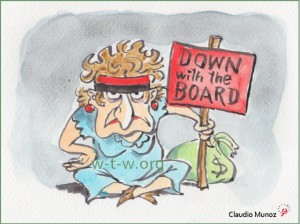Caroline Fairchild writes: Women occupy just 16.9% of Fortune 500 corporate board seats today, and progress has been slow. A new report from the Committee for Economic Development outlines how we can increase the rate of change.
After years of making the business case for diverse boards via research and panel discussions, it’s time for a different approach.
Despite all of the studies showing corporate boards with female directors perform better than all-male peers, women occupy only 16.9% of Fortune 500 corporate board seats today. In the last decade, that percentage has grown by just 3.3%.
“We don’t need any more studies, we get it,” says Janice Ellig, the co-CEO of executive search firm Chadick Ellig. “There is a pipeline out there of very talented women running major divisions at companies or law firms or working in science and they should be sitting on boards.”
To accelerate change, the Committee for Economic Development, a business-oriente public policy group, plans to go directly to nominating committees of prominent corporate boards to engage them in a dialogue on the issue. By making some simple changes in the way that they think about recruiting new board directors, the CED believes the U.S. can achieve 30% female representation on corporate boards by 2018.
“You get a lot further by talking with people rather than talking at them,” says Debra Perry, the co-chair of CED’s women’s economic contribution subcommittee. “There is a vast amount of research and public relations efforts that have been underway, but there still has been very little progress.”
To get to the goal of 30% female representation in four years, every other board seat that becomes available between now and 2018 will have to be filled by a woman. While the goal might sound impossible given how slowly things are currently moving, the CED suggests in a new report that expanding the criteria for qualified directors will go a long way to getting results. Nominating committees typically draw up an excessively narrow list of qualifications for directors.
Former or current CEOs are considered to be the ultimate prize for elite companies searching for board members. Only 5% of CEOs at Fortune 500 companies are women, so this narrow definition of qualified candidates considerably shrink the talent pool. Yet if nominating committees more aggressively recruited slightly lower ranking leaders – divisional presidents, law firm partners, financial service executives and entrepreneurs – a lot more women would be eligible.
The CED is not recommending the U.S. consider government-mandated quotas for women on boards. While several European countries such as France, Spain and Norway have increase the diversity of their boards this way, the CED believes this is an intrusive regulation that will make people view female appointees differently by their male peers on the board.
Qualified female candidates also need to step up. Gerri Elliott, a director Whirlpool Corporation WHR 0.95% , Bed Bath and Beyond BBBY -0.51% and Charlotte Russe, has a combined 34 years of senior executive experience at tech business like IBM IBM -1.38% and Microsoft MSFT -0.83% . Yet when she decided over a year ago to look for her first seat on a public board, she had a hard time finding the right opportunity.
“The CED report outlines well how we need to increase the diversity of our boards for good business reasons,” says Elliott, a CED trustee. “We haven’t moved the needle fast enough. But it’s also up to women to help themselves by aggressively getting a plan in place to make it happen.”
The CED’s call to bring in one woman for every man that gets a new board seat in the next four years, will hopefully change the current approach.

